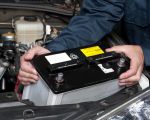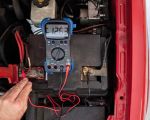How to Store a Car Battery When Not in Use
As car owners, we’ve all been there—whether it’s during the winter months, when your vehicle is parked for an extended period, or when you simply decide to store your car for a few months. At some point, you might find yourself wondering how to properly store your car’s battery when it’s not in use. A car battery is an essential component of your vehicle, and knowing how to properly care for it during a long-term storage period is crucial to ensuring that it remains in good condition when you’re ready to use your car again.
There’s no doubt about it: batteries are expensive and replacing them prematurely can be a financial burden. But when a battery is neglected or improperly stored, it can lose its charge and deteriorate faster. This is why proper storage is vital. Let me walk you through the essential steps to ensure your car battery is stored correctly and stays healthy, ready for when you need it most.

NTB-National Tire & Battery
6315 Prentiss School Dr, Canal Winchester, OH 43110, USA
1. Understanding Your Car Battery
Before diving into the proper storage methods, it’s essential to understand how a car battery works. Most car batteries today are lead-acid batteries, and while they are designed to provide reliable performance under normal circumstances, they need to be treated carefully to avoid damage. Over time, batteries can slowly lose their charge, a process known as self-discharge. Storing a car battery improperly can accelerate this process, leaving you with a dead or damaged battery when you need it most.
The good news is that a little preparation and proper care can significantly extend the life of your car’s battery. By following the correct procedures, you can make sure the battery remains charged and in good working order, ready to jumpstart your car when you return to it.

Pep Boys
1200 W Washington Blvd, Los Angeles, CA 90007, USA
2. Preparing Your Battery for Storage
The first step in storing a car battery is to prepare it properly. This involves a few critical steps to ensure the battery is in the best possible condition before it’s stored for an extended period. Here’s what you need to do:
Step 1: Disconnect the Battery
The first thing to do is disconnect the battery from the vehicle to prevent any electrical drains. If you leave the battery connected, even with the car off, some systems may continue to draw power. This gradual discharge can lead to the battery losing its charge over time. Start by removing the negative terminal first, followed by the positive terminal. This step ensures that there’s no risk of electrical shock or accidental short-circuiting.
Step 2: Clean the Battery Terminals
Before storing the battery, it’s crucial to clean the battery terminals. Dirt, grime, and corrosion can accumulate over time, making it harder for the battery to deliver power. Use a wire brush or a specialized battery terminal cleaner to remove any corrosion. Make sure both the terminals and the cable clamps are thoroughly cleaned to ensure a clean connection when you reconnect the battery later.
Step 3: Inspect the Battery
While cleaning, take a moment to inspect the battery. Check for signs of damage, leaks, or bulging. A battery that shows signs of wear or damage might not be able to hold a charge properly. If you notice any of these signs, it might be time to replace the battery. It’s also a good time to check the fluid levels (if your battery has removable caps) and top it off with distilled water, if necessary.
3. Choosing the Right Storage Location
Once the battery is disconnected and cleaned, the next step is to choose the right storage location. Where you store the battery is just as important as how you store it. The ideal environment for a car battery is cool, dry, and well-ventilated. Storing the battery in a hot or humid environment can shorten its lifespan and cause it to deteriorate much faster.
Step 1: Avoid Extreme Temperatures
One of the worst things you can do to a car battery is expose it to extreme temperatures. High temperatures can cause the battery fluid to evaporate, leading to internal damage. On the other hand, freezing temperatures can cause the battery to freeze, which can rupture the casing and render it useless. A temperature-controlled room, such as a basement or garage, is the best place for storing your battery. Avoid storing it in a hot attic or a freezing shed.
Step 2: Use a Battery Storage Box
If possible, place the battery in a plastic storage box or container to protect it from dust and moisture. This will also help keep any accidental spills contained. Make sure the storage box is vented to allow for the escape of any gases the battery may release during the storage period.
4. Charging and Maintenance While Storing
Once your battery is securely stored, the next step is to ensure it maintains its charge. A car battery naturally discharges over time, and without maintenance, it could be completely dead by the time you need it again. To prevent this, follow these maintenance tips:
Step 1: Charge the Battery Before Storing
Before you store your battery, make sure it’s fully charged. A battery that’s only partially charged will have a much higher chance of deteriorating during storage. If you have access to a battery charger, give it a full charge before disconnecting and storing it. This will give it the best chance to maintain a healthy charge while it’s not in use.
Step 2: Use a Battery Maintainer or Trickle Charger
If you plan on storing your battery for an extended period (more than a few weeks), consider using a battery maintainer or trickle charger. These devices slowly charge the battery over time, keeping it at an optimal charge level without overcharging it. This is especially helpful for those who store their vehicles for months at a time, as it ensures the battery will be ready to go when you need it again.
5. Reinstalling the Battery
When you're ready to use the car again, reinstalling the battery is a relatively straightforward process. Begin by placing the battery back into the vehicle and reconnecting the positive terminal first, followed by the negative terminal. Make sure the terminals are clean and tight to prevent any electrical issues.
Once the battery is reinstalled, start your vehicle and let it run for a few minutes to ensure everything is functioning properly. If your battery has been stored correctly, it should be fully functional and ready to power your car once more.
6. When to Replace Your Car Battery
Even with the best care, car batteries eventually wear out and need to be replaced. If your car has trouble starting, or if the battery is showing signs of corrosion, leakage, or swelling, it might be time for a replacement. Replacing a battery every few years ensures that your car always has reliable power, especially when stored for long periods.
In some cases, if your car battery has been stored improperly or has been left without charge for too long, it may be permanently damaged and unable to hold a charge. If this happens, the best course of action is to take it to a professional for disposal and purchase a new one. You can also contact a towing service, like Rescue & Towing, for help with transporting your vehicle or replacing the battery.
Storing a car battery may seem like a daunting task, but with the right preparation and maintenance, it can ensure your vehicle is ready to go when you are. By following these steps, you can protect your investment and avoid the hassle and expense of premature battery failure.
OLD Keywords: car battery storage, how to store a car battery, maintain a car battery, battery storage tips, battery maintainer, battery charger, keeping car battery healthy SEO Title: How to Store a Car Battery When Not in Use SEO Keywords: car battery storage, how to store a car battery, maintain a car battery, battery storage tips, battery maintainer, battery charger, keeping car battery healthy SEO Description: Learn how to properly store your car battery when not in use, including key steps for maintaining charge, avoiding damage, and tips for long-term storage.

























